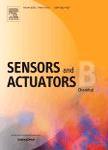版权所有:内蒙古大学图书馆 技术提供:维普资讯• 智图
内蒙古自治区呼和浩特市赛罕区大学西街235号 邮编: 010021

作者机构:Linkoping Univ Appl Phys Lab S-58251 Linkoping Sweden Linkoping Univ S SENCE S-58251 Linkoping Sweden
出 版 物:《SENSORS AND ACTUATORS B-CHEMICAL》 (传感器与执行机构,B辑:化学传感器)
年 卷 期:1997年第45卷第1期
页 面:71-77页
核心收录:
学科分类:12[管理学] 1201[管理学-管理科学与工程(可授管理学、工学学位)] 08[工学] 0804[工学-仪器科学与技术] 0703[理学-化学]
基 金:Swedish Industry Swedish National Board for Industrial and Technical Development Linköpings Universitet, LiU Vetenskapsrådet, VR
主 题:Pd-MOSFET gas sensor distributed sensor system catalytic surface selectivity
摘 要:When a gas mixture is passed over a catalytic surface its composition will change due to the catalytic activity of the surface. Different molecules have different reaction rates and this fact can be used in combination with distributed chemical sensors to increase the discriminating capability of the sensors. in a measurement cell (palladium covered or non-covered) a row of identical Pd-MOSFET sensors was mounted along the flow direction. The catalytically active measurement cell changed the concentration of detected molecules (hydrogen or ethanol) considerably compared to the non-catalytic cell. It was observed that even catalytic combustion in the lid 1 mm above the sensor row influenced the sensor responses significantly. When comparing hydrogen and ethanol it was found that the two molecules were influenced to different degrees when passing the catalytic surfaces. Hydrogen was consumed at a much faster rate, which could tie seen when comparing the sensor responses along the row. A distributed sensor system thus shows an increased discriminating power. It was also found that chemical sensing was much more temperature dependent for ethanol than for hydrogen. (C) 1997 Elsevier Science S.A.